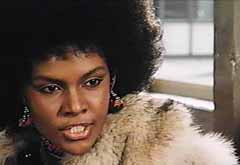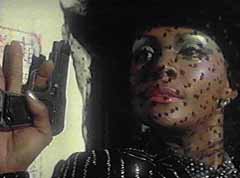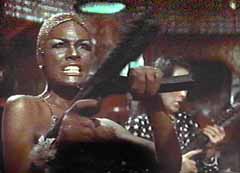|
In odd ways, Cleo's outrageous outfits are also analogous with Bond's dinner jackets and playboy wardrobe. Cleo's three foot hat brims and flowing fur robes are treated with respect and awe within the film, just as Bond's refinements are looked upon as the height of good taste. Also, both their wardrobes connote each one's sexuality but to different degrees. While Bond is often decked out in refined clothing that connotes his English-ness and power as man, Cleo's clothes connote her as sexually available through their fetishistic qualities. Her frequent use of fur also links her sexuality to black misrepresentations of animality.3

Tamara Dobson in Cleopatra Jones.
Cleopatra Jones and The Casino of Gold is another excellent example of the influence of Bond on the spy thriller. Here, Cleo has been sent to locate two black government agents who were posing as heroin buyers in Hong Kong. They contact an Asian drug lord named Chen, who is trying to take over the Hong Kong drug trade from Mr. Big, who turns out to be Ms. Big, a white lesbian drug lord named the Dragon Lady. The Dragon Lady busts up the drug deal and kills Chen who has betrayed her. She then takes the two agents captive until she can verify their credentials as actual drug smugglers. She houses them in her casino where they are pampered in luxury by her Asian sexual slaves, who also turn out to be her adopted daughters. This fact doesn't prevent the Dragon Lady from incestuous lesbian love scenes however. Cleo escapes from several traps set for her by the Dragon lady and she eventually pays a visit to the Dragon Lady's casino, where she rescues the two agents and kills the villain.

Tamara Dobson in
Cleopatra Jones and the Casino of Gold.
The Casino of Gold reflects its Bond influence in several ways. The character of the Dragon Lady is also known as Mr. Big. The male title calls to attention her lesbianism but it also resonates with the villain in both the novel and film of Live and Let Die. The title itself recalls two words often associated with Bond. Gold is used throughout Bond as a recurring factor (Goldfinger, The Man with the Golden Gun, Goldeneye.) Oddly, gold plays no part in The Casino of Gold's narrative. Of course casinos appear with regularity in most Bond films (including the first Bond novel, Casino Royale). In Bond, the gambling table serves to demonstrate 007's superior wit, refinement and luck. In The Casino of Gold similar elements can be attributed to Cleo, however an intertext with other blaxploitation films complicates matters. Gambling is used throughout black films as part of "the life." When Cleo sits down at the gambling table, she not only recalls Bond, but also the craps games so prevalent in other blaxploitation films. This serves not only to align Cleo with Bond, but also keeps her firmly rooted in the tradition of blaxploitation characterizations. By being aligned with Bond she is also aligned with his whiteness. The intertextual element of gambling, along with mis-perceptions of black animality and Cleo's firm rooting in blaxploitation characterizations, keeps her aligned with blackness, and specifically blackness as seen in blaxploitation.

Tamara Dobson in
Cleopatra Jones and the Casino of gold.
The importance of Cleo being separated from Bond lies in the area of co-optation itself. Cleo is not simply a black James Bond. While the Cleopatra Jones films have co-opted Bond, they avoid a total fusion of her character with that of Bond. As will become evident after the discussion of Live and Let Die, the co-optation in the Cleo films is not just a simple borrowing of tropes, it is also a critique of Bond ideology. Of the Bond films of the 1960s, Tony Bennett and Janet Woollacott have posited:
Drawing together and working upon a series of ideological tensions in relation to the nation, gender and the Cold War, they operated both to shift and stabilize subject identities at a time when existing ideological constructions had been placed in doubt and jeopardy, when, if you like, the articulating principles of hegemony were in disarray and alternatives had not been successfully established. (280)
To this list of nation, gender and the Cold War, race can easily be added. It was "existing ideological constructions" of race that blaxploitation was putting into "doubt and jeopardy" in the 1960s and 1970s. Both the Bonds of the 1960s and Live and Let Die can be seen as efforts to stabilize white hegemony in the face of global nationalist tensions and rising black militancy. Bennett and Woollacott also state that, "[T]he geographical and racial distribution of villainy is also such that the villain is always a member of a non-Anglo-Saxon race" (72). It is this very fact that the Cleo films critique. By reversing villainy to include whiteness, Cleo's appropriation of Bond draws direct intertextual links with Bond and therefore directs criticism of their racist elements directly back to Bond. The intertext forms a sort of bridge between the films where responses and critiques can pass. This is why it is important for Cleo to maintain her footing in representations of blackness (albeit negative ones repeated throughout blaxploitation). She has to bring a critique of Bond to the attention of the spectator, while at the same time distancing herself from him so as not to implicate herself in his whiteness and class.
page 3 of 5
 
You can move through the article by selecting "next page," or you can go to a specific section of the article by using the links below. In addition, you can check out our selection of links for blaxploitation Web sites.
Chris Norton received his B.A. in English and Film Studies from Oakland University, Rochester, Michigan and an M.A. from New York University in the Department of Cinema Studies. Chris welcomes comments or questions about his article. You can reach him at norteiga@aol.com.
|





